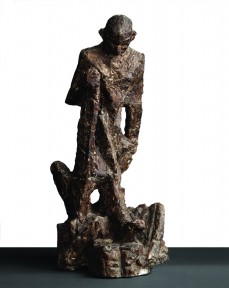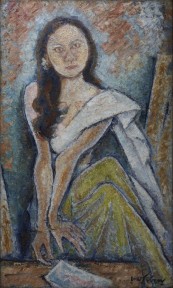It may be a delayed tribute, but the expanse of the retrospective show of Ramkinkar Baij, celebrated as pioneer of modern Indian sculpture, leaves no room for any complaint. Hosted by the National Gallery of Modern Art, New Delhi and curated by sculptor K.S Radhakrishnan, who was also a student of Baij, the retrospective includes over 350 works in paintings, drawings, graphics and sculptures, covering about six decades of Baij’s artistic journey. The exposition is also enhanced by diverse media interventions such as photographic blow ups, digital prints, texts and video clips in an attempt to contextualise the man and the artist in the most comprehensive manner.
Baij was born in Bankura, West Bengal, into a family of little economic and social standing, and grew by sheer determination, into one of the most distinguished early modernists in Indian art. In 1925, he made his way to Kala Bhavan, the art school at Santiniketan and was under the guidance of Nandalal Bose where his artistic skills blossomed acquiring greater depth and complexity. Soon after completing his studies at Kala Bhavan, he became a faculty member, and along with Bose and Benodebehari Mukherjee played a pivotal role in making Santiniketan one of the most important centres for modern art in pre-Independent India. In 1970, the Government of India honoured him with the Padma Bhushan for his contribution to Indian art.
Ramkinkar’s monumental sculptures established landmarks in public art. One of the earliest modernists in Indian art, he assimilated the idioms of the European modern visual language and yet was rooted it in his own Indian ethos. He experimented restlessly with forms, moving freely from figurative to abstract and back to figurative, his themes were steeped in a deep sense of humanism and an instinctive understanding of the symbiotic relationship between man and nature.
Both in his paintings and sculptures, he pushed the limits of experimentation and ventured into the use of new materials. For instance, his use of unconventional material, for the time, such as cement concrete for his monumental public sculptures set a new precedent for art practices. The use of cement, laterite and mortar to model the figures, and the use of a personal style in which modern western and Indian pre-classical sculptural values were brought together was equally radical.
Radhakrishnan says: “My curatorial venture aims at flagging those junctures where Ramkinkar Baij met all those who travelled before him, with him, and after him. In other words, this retrospective aims to be a context in which the post 1980s generation of Indian artists see, accept, reject, understand or misunderstand the master creator, the artist, the man, Ramkinkar Baij”.
Says Rajeev Lochan, Director, NGMA: “Perceived as a bohemian, Baij has been the subject of much mythification. His powerful experimentations, ranging from the representational to the abstract have inspired generations of younger artists. The exhibition sheds light on an enlightened and creative soul who was more of a fakir and a wanderer and through his work represents the larger-than-life persona of the artist and his creative genius.”
Ramkinkar Baij: A retrospective is on at NGMA, Jaipur House, New Delhi till April 31, 2012 and will subsequently travel to Mumbai and Bangalore.







